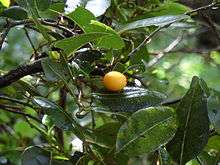Drypetes deplanchei subsp. affinis
Drypetes deplanchei subsp. affinis, commonly known as greybark or grey bark, is a flowering plant in the Putranjivaceae family. The subspecific epithet affinis ("similar to") alludes to its similarity to Drypetes sepiaria of India and Sri Lanka.[1]
| Drypetes deplanchei subsp. affinis | |
|---|---|
 | |
| Leaves and fruit | |
| Scientific classification | |
| Kingdom: | Plantae |
| Clade: | Tracheophytes |
| Clade: | Angiosperms |
| Clade: | Eudicots |
| Clade: | Rosids |
| Order: | Malpighiales |
| Family: | Putranjivaceae |
| Genus: | Drypetes |
| Species: | |
| Subspecies: | D. d. subsp. affinis |
| Trinomial name | |
| Drypetes deplanchei subsp. affinis | |
| Synonyms | |
| |
Description
It is a tree growing to 16 m in height, with smooth, pale grey bark often mottled pink with lichens. The leathery, oval leaves are usually 50–80 mm long and 30–40 mm wide. The small green flowers are 6 mm across, appearing from the end of December to late January. The oval, orange-red to yellow fruits are 20–25 mm long.[1][2]
Distribution and habitat
The subspecies is endemic to Australia's subtropical Lord Howe Island in the Tasman Sea. There it is one of the most common and widespread trees in the lowlands.[1][2]
References
- " Drypetes deplanchei subsp. affinis ". Flora of Australia Online: Data derived from Flora of Australia Volume 49 (1994). Australian Biological Resources Study (ABRS). Retrieved 2014-02-26.
- Hutton, Ian (1998). The Australian Geographic Book of Lord Howe Island. Sydney: Australian Geographic. p. 139. ISBN 978-1-876276-27-0.
This article is issued from Wikipedia. The text is licensed under Creative Commons - Attribution - Sharealike. Additional terms may apply for the media files.